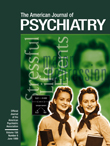Dr. Roberts Replies
To the Editor: We thank Henry Kaminer, M.D., and Marcia Kaplan, M.D., for their thoughtful responses to our Clinical Case Conference. This case was meant to be evocative. This was our aim because Brother David, his remarkable request, and his “outcome” were so compelling and distressing and he evoked so much in us. Indeed, his tale is rich with lessons about psychiatric practice, its ethics, and our culture.
We thoroughly agree with Drs. Kaminer and Kaplan that Brother David was deeply troubled, that his history was fully manifest in his everyday suffering, that his character was problematic and vulnerable, and that his defenses were maladaptive. This is especially obvious in hindsight. We agree that Brother David was guarded and evasive about his “spiritual” life, even when pressed for details. We agree that cults are not “religions.” We agree that cult participation may be an indication of serious psychopathology, either axis I or II, although we are also persuaded by empirical work suggesting that the profoundly coercive techniques of cultism make every individual potentially vulnerable to their effects, particularly when undergoing significant and disruptive life changes (1). We further agree that general psychiatrists and psychiatric consultants should be highly attuned to the themes and defensive styles and mechanisms of their patients in order to understand and help them. Finally, we agree that Brother David was “probably too enmeshed” in his cult experience to participate in treatment. In fact, Dr. Hollifield sought guidance on the case from two other psychiatrists, both of whom recommended therapy for Brother David and one of whom doubted that treatment would be accepted or helpful. Brother David rejected psychotherapy.
We disagree, however, with some of the comments offered in the two letters largely because of the assumptions made by their authors. For instance, the assumption that the consultant did not appreciate or interpret the meaning of Brother David’s experiences is incorrect. In fact, Drs. Kaplan and Kaminer’s comments about Brother David’s psychological issues derive from the story we provided. The consultant gathered details about Brother David’s upbringing and psychosexual issues and, although we did not speculate beyond our understanding, included them purposefully for readers. Second, we disagree with Dr. Kaminer, who suggests that the consultant performed only a mental status examination in five sessions and asserts that he “entered” Brother David’s “psychosis” by seeking to clarify his concerns and exploring alternative approaches to treating his ego-dystonic symptoms. Creating the alliance necessary to evaluate Brother David was delicate and difficult. To whatever extent it existed to allow for five full sessions with this elusive man, it was not attained through “cookbook” methods.
The point of our Clinical Case Conference really was not so much about cults, as worrisome as they are. Nor was it about one man’s tragic story, as important as this was. Rather, it was about our need, as psychiatric clinicians, to remain humble and diligent in our efforts to understand, evaluate, and care for highly complex and seriously disturbed patients who may at times deceive, surprise, and befuddle us. This is at least one of the morals of the story.
1. Lifton RJ: The Future of Immortality and Other Essays for a Nuclear Age. New York, Basic Books, 1987Google Scholar



